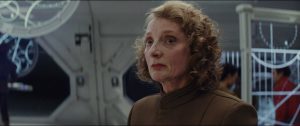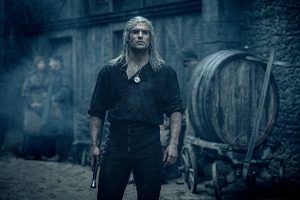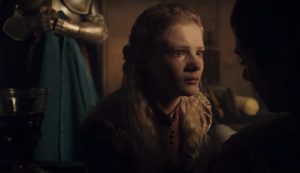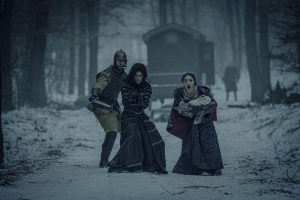The final episode of The Mandalorian‘s first season on Disney+ is quite appropriately titled Redemption – for not only does the title work in-universe, but it’s also an amusingly apt reflection on the fact that Redemption very literally redeems the slow-paced series’ many mishaps. The plot itself often seemed like an afterthought while Mando (Pedro Pascal) and his tiny, adorable sidekick Baby Yoda traveled the galaxy, stopping in at random planets to marvel at the visual spectacle and meet new friends – or enemies. But in the season finale, masterfully directed by Taika Waititi, the story is rich, thrilling, entertaining and emotional; the characters feel more fleshed-out than they have appeared previously; and, most importantly, Baby Yoda is the cutest we’ve seen him yet.
And that’s all I’ll say in the non-spoilers section. If you haven’t watched the episode yet, but plan to, then turn away now! SPOILERS AHEAD!
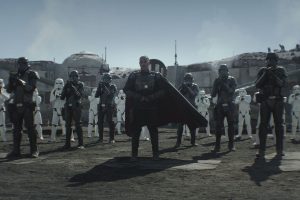
The finale is chock-full of plot twists and gasp-out-loud revelations, but none more bewildering than the fact that Taika Waititi, who has never directed a Star Wars property previously, is somehow able to ease into the director’s chair for Redemption with all the graceful assurance of Dave Filoni, who at first glance would seem the natural choice to bring this series home to its epic (and thankfully, only temporary) conclusion. Waititi’s work here is surprisingly understated: you’d be hard-pressed to find any clues that this episode comes from the mind that brought you crazy, colorful comedies like Thor: Ragnarok or Jojo Rabbit (though it is amusingly unsurprising that the finale stars Waititi’s own character, assassin turned nurse droid IG-11, in a particularly prominent role). Obviously, directing a single good episode of TV doesn’t warrant immediately getting a three-picture deal with Lucasfilm, but hey, why not give Waititi a shot at his very own Star Wars trilogy?
Another surprise that boggled my mind, at least, was that Mandalorians are cool – for what I feel is the first time, despite everyone else in the world idolizing the very ground that Boba Fett walks upon. And one of the coolest things about them (apart from jetpacks and flamethrowers) is that they’re not a specific race of people, as Cara Dune (Gina Carano) reveals during an emotional moment in the episode: they’re a creed. Not only does it reinforce a particularly Rian Johnson theme in Disney’s Star Wars, that anyone can be a Mandalorian without having to have been born one, but it also makes the Mandalorians seem a lot more noble – in an extended flashback sequence which haunts our protagonist’s mind, we witness a squad of the flying, armored warriors acting as human shields for wounded refugees trying to escape from brutal droid-warfare: and it is revealed that during this battle, a young orphaned boy named Din Djarin was rescued by these Mandalorians and taken to safety with them – that boy was our very own “Mando”, whom I guess we can finally call Din Djarin? We’ve actually known that name for a while (Pedro Pascal ever-so-slightly spoiled it last month), but it’s only now canon, meaning I can only now use it. Yes, the Mandalorians are still vaguely cultish, and more than a little creepy, but at least they’re not solely defined by characters like Jango and Boba Fett anymore, or even just the term of “bounty hunter”. Djarin’s other biggest secret, his face, was also finally revealed in this episode…and, well, it’s Pedro Pascal’s face. I’m not entirely sure what we were all expecting, but honestly, that reveal was a bit underwhelming. It’s not like his face was even altered in any way: he didn’t have any scars or third-degree burns to speak of, no missing eyes or other distinguishing facial features. Not even a different hair color.
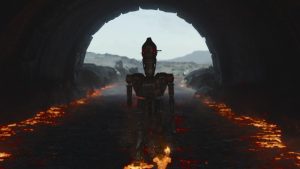
Djarin’s secrets weren’t the only ones brought to light: IG-11 is revealed to have been entirely reformed by Kuiil’s repairs, riding in to rescue Baby Yoda from a couple of monstrous stormtroopers who amuse themselves by punching and mocking the adorable little infant – the droid then straps The Child into a baby-backpack and goes on a killing spree around Nevarro, mowing down stormtroopers. He later sacrifices himself to rescue the whole team, self-destructing and blowing an entire legion of enemies sky-high. Baby Yoda himself is given his own hero moment when he faces down a flamethrower-wielding stormtrooper and deflects the attacker’s fire back at him: there’s a couple more reveals about his character, but I need to address those separately. Then there’s Cara Dune, whose home planet is revealed to be Alderaan (Princess Leia’s planet, infamously blown to pieces by the Death Star in A New Hope), thus explaining her undying grudge against the Empire. Greef Karga (Carl Weathers) turns out to have been an ex-Imperial himself, though that big secret falls a little flat due to the fact that we barely even know Karga, and have always been on-the-fence about whether or not to trust him and his Bounty Hunters Guild, anyway.
The person doing a lot of this dramatic-revealing is none other than Moff Gideon (Giancarlo Esposito), who is being set up to be the series’ big bad, and Din Djarin’s arch-nemesis. Gideon toys with his victims as they shelter in the burnt-out rubble of Werner Herzog’s lair, spilling their secrets to the world and promising them tantalizingly good deals if they’ll only hand over Baby Yoda. We never do find out what Gideon or Herzog wanted with The Child (and, come to think of it, we never even found out Herzog’s character name or purpose in the story, before he was unceremoniously murdered in the assault on his hideout), but considering how despicably evil Gideon is revealed to be, I’m going to assume it’s not because either of them just wanted cuddles and hugs. Gideon is also shown to have an alarmingly dangerous arsenal: not only can his tiny little handgun pierce through beskar steel, but the Moff is also a trained TIE-fighter pilot capable of handling his own in a dogfight. Oh yeah, and he just so happens to be in possession of the one black lightsaber in the entire galaxy, no biggie.
The lightsaber in question, better known as the Darksaber, has never been seen in live-action before this day, though it was seen in the animated series, Star Wars Rebels, which gave us a couple clues about the saber’s history. It was crafted by Tarre Vizsla, the first Mandalorian Jedi, during the reign of the Old Republic, and has since meandered across the universe, through the hands of a number of notable peoples and individuals, including the belligerent Mandalorian Clan Vizsla (to whose ranks Din Djarin appears to belong), the legendary Sith Lord Darth Maul, and Nite Owls leader Bo-Katan, who was the last known person to wield the blade, almost a decade before we seen Moff Gideon crawl from the wreckage of his TIE-fighter with the weapon in hand. The Darksaber is something of a mystical item, bestowing upon its wielder the title of Mand’alor, or leader of the Mandalorians – Gideon certainly has a fascination with the religious order, having been personally involved with eradicating them during the Great Purge and keeping tabs on those who survived. And now that he’s back on his feet, we can safely assume Din Djarin and Baby Yoda won’t be safe from his murderous rage anytime soon.
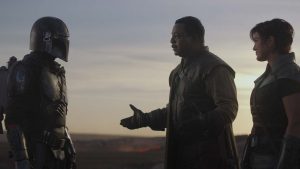
But for the moment, Din has a more urgent problem to worry about: while visiting his old friend The Armorer (Emily Swallow), he was gifted a number of odds-and-ends, including his very own jetpack, a personal sigil, and custody over Baby Yoda – which, apparently, is something that The Armorer can just hand out to anybody she feels like. But there’s a catch: while she tells Djarin to protect and train the baby (and even bestows upon them a title, the “Clan of Two”, which seems to hint at Star Wars’ common theme of duality), she also instructs him to seek out the child’s people – it’s not clearly indicated whether she’s referring specifically to Baby Yoda’s birth-family, or the Jedi in general, but it’s obvious that this will be a central plot-point in the series’ second season. But honestly, as much as we all want to see a whole planet of Baby Yodas, I think I’m just as excited to see The Child training as a Mandalorian – just so long as Din Djarin doesn’t try to make him wear a ridiculous helmet of his own: Baby Yoda’s adorable, expressive little puppet-face will not be hidden from the world, not if I and the internet have anything to say about the matter.
For the record, I think there’s a decent chance that we do actually see the home-planet of The Child’s species in The Mandalorian, and that the Jedi sage Yaddle will be revealed to be his mother. I know, I know, Yaddle is presumed dead – but there’s never been any conclusive evidence that that is the case, and honestly, she deserves so much more recognition than she gets. You know what, I’m just gonna say it: I think Yaddle is a better character than Yoda. Come at me, Yoda stans!
We’ve been left with a number of pressing questions from the season finale, but a bunch of mysteries have also been resolved, and we’ve left Din Djarin and Baby Yoda in a good place, all things considered. What did you think of the finale? Are you excited for Season 2? Share your thoughts and theories in the comments below!
Episode Rating: 9/10
